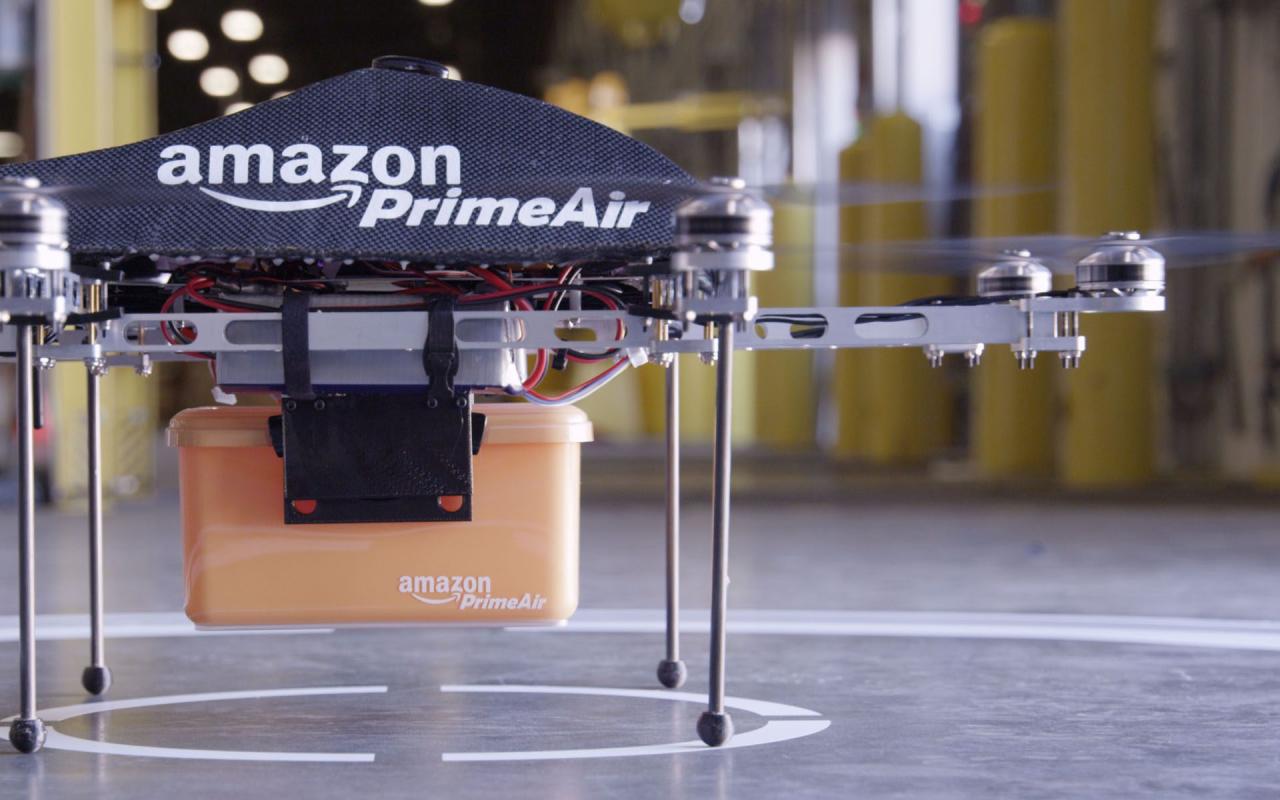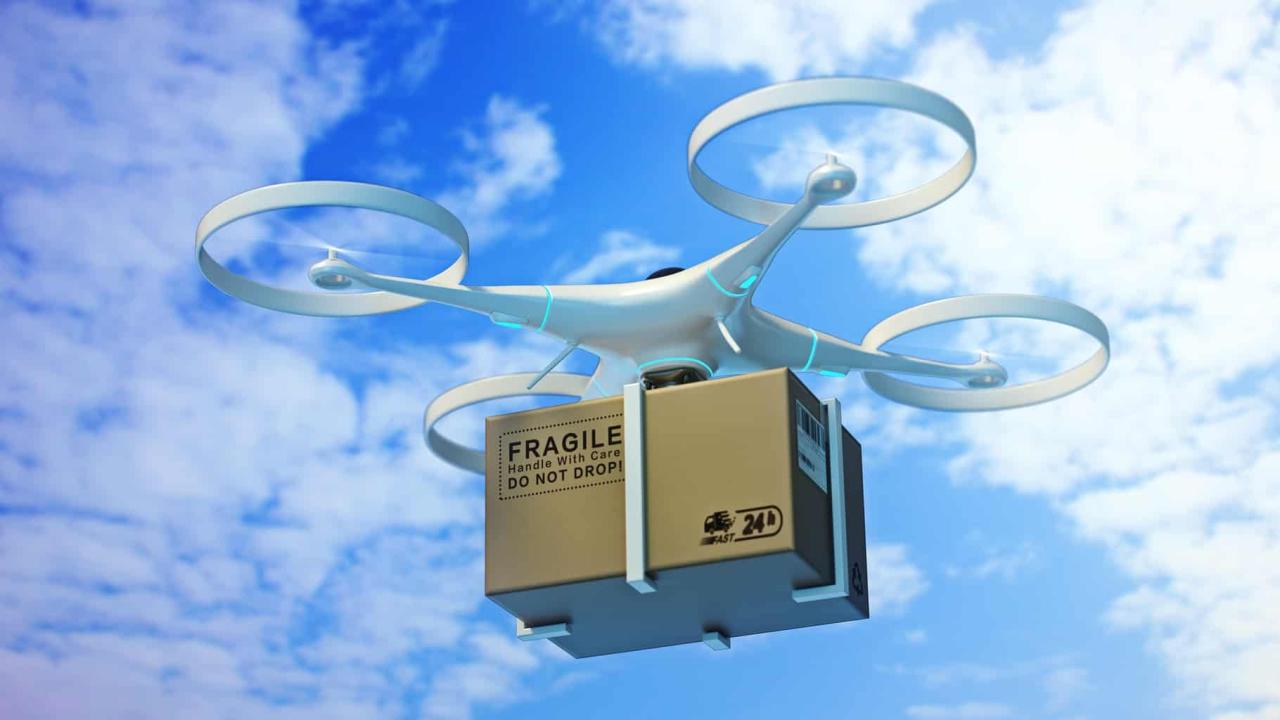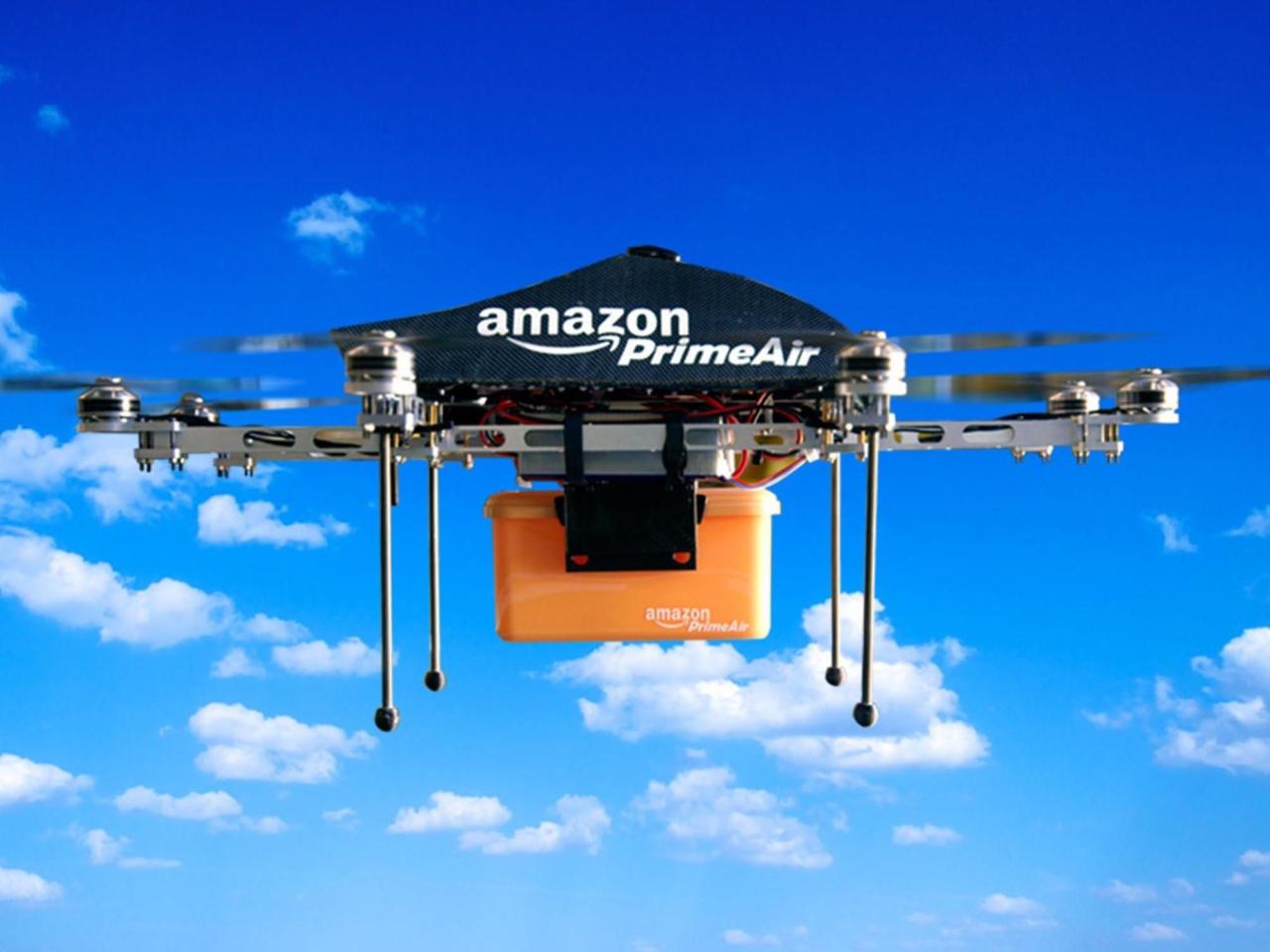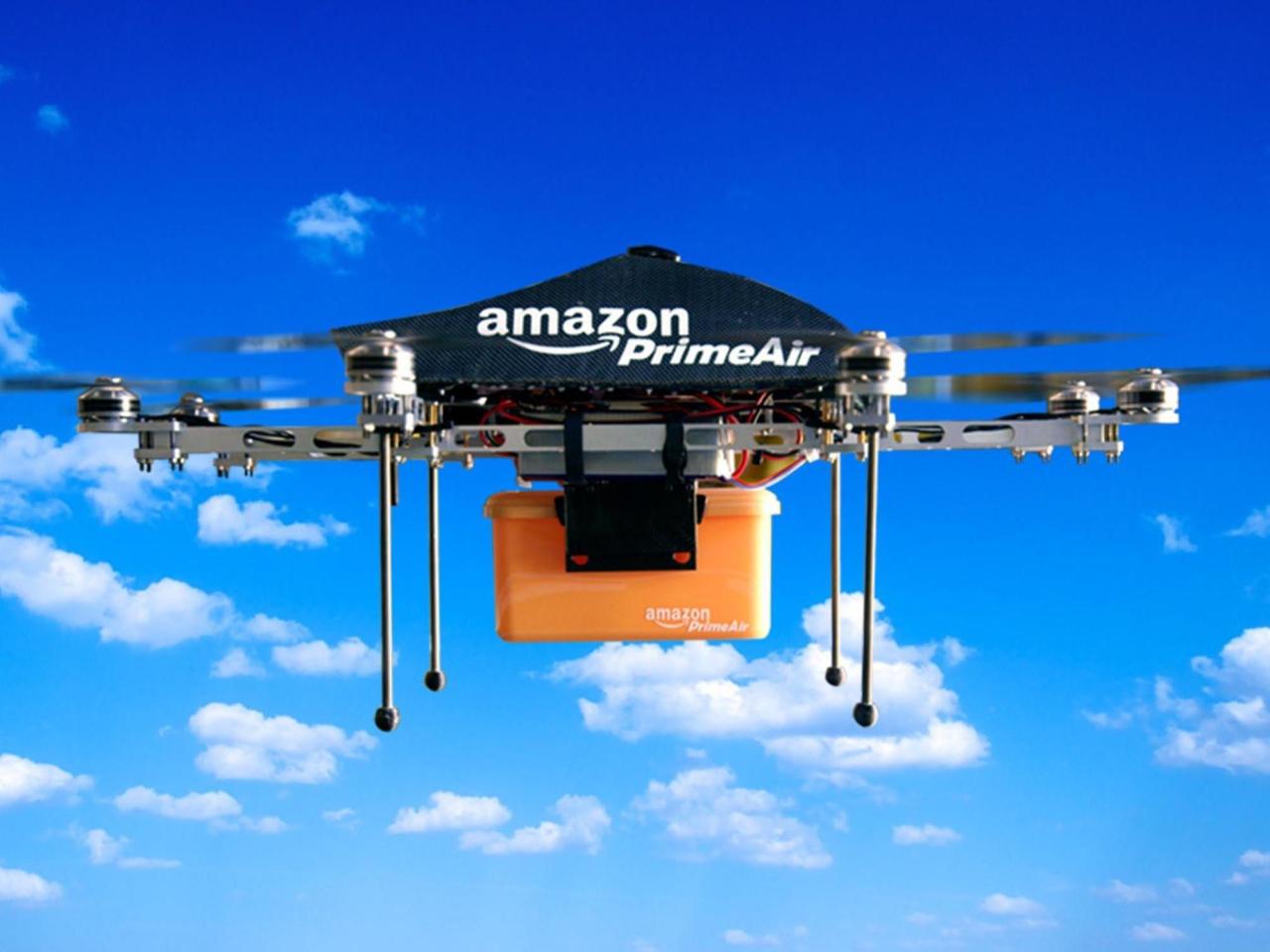Amazon drone delivery locations are rapidly expanding, revolutionizing how we receive packages. This innovative approach promises faster delivery times and reduced environmental impact, but its implementation faces unique challenges. We’ll explore the current state of Amazon’s drone delivery program, the factors influencing location selection, the customer experience, future expansion plans, safety regulations, and the economic implications of this transformative technology.
From logistical hurdles like airspace regulations and infrastructure needs to the crucial role of customer feedback and the potential for economic disruption, we’ll delve into the complexities of bringing drone deliveries to your doorstep. We’ll also examine the safety protocols, regulatory frameworks, and environmental considerations that shape this evolving landscape.
Current Amazon Drone Delivery Program Status
Amazon’s drone delivery program, officially known as Amazon Prime Air, is steadily expanding its reach and capabilities, though it remains a relatively limited service compared to traditional delivery methods. While still in its developmental stages, it represents a significant step towards faster and more efficient delivery solutions, particularly in geographically challenging areas.Amazon Prime Air’s current geographic scope is limited to specific areas within the United States.
The service isn’t available nationwide, and even within operational areas, availability is restricted to select neighborhoods and towns. This targeted approach allows Amazon to carefully test and refine the technology in controlled environments before wider implementation.
Geographic Scope of Amazon Drone Delivery
The program’s operational areas are carefully chosen based on factors such as population density, airspace regulations, and infrastructure availability. Currently, Amazon primarily focuses on areas with relatively low air traffic and suitable infrastructure for drone operations. The company regularly announces expansions into new locations as its technology and regulatory approvals mature. These expansions are incremental, focusing on manageable growth rather than rapid, widespread deployment.
Types of Goods Eligible for Drone Delivery
Currently, the range of products eligible for Amazon Prime Air delivery is restricted. Only smaller, lightweight packages are suitable for drone transport. This typically includes everyday items like household goods, personal care products, and certain types of electronics. Larger, heavier, or fragile items are not yet feasible for drone delivery due to weight and safety limitations of the drones themselves.
Amazon carefully curates the selection of eligible items to ensure safe and efficient transport.
Technological Infrastructure for Amazon Drone Delivery
Amazon’s drone delivery system relies on a complex interplay of technologies. This includes a fleet of purpose-built drones equipped with advanced sensors, GPS navigation, and obstacle avoidance systems. These drones are remotely monitored and controlled through Amazon’s sophisticated control center infrastructure. This infrastructure incorporates real-time data analysis, flight path optimization, and safety protocols to ensure safe and efficient operations.
The system also requires robust communication networks to maintain constant contact with the drones and manage data transmission. Furthermore, Amazon invests heavily in developing and improving drone technology, constantly refining its designs to increase payload capacity, flight range, and overall reliability.
Comparison with Other Drone Delivery Initiatives
Several companies are pursuing drone delivery initiatives, each with varying levels of success and operational scope. Compared to competitors like Wing (Alphabet’s drone delivery service) and Zipline (focused on medical deliveries), Amazon Prime Air benefits from the company’s existing infrastructure and logistical expertise. However, the large-scale deployment and regulatory challenges associated with drone delivery pose similar hurdles for all players in the industry.
The competitive landscape involves navigating complex regulations, securing necessary approvals, and continuously improving drone technology to enhance safety and efficiency. Ultimately, the success of each program will depend on factors such as technological advancements, regulatory approvals, and public acceptance.
Factors Influencing Location Selection for Drone Delivery

Choosing the right locations for Amazon’s drone delivery service is crucial for success. Several interconnected factors determine where these operations can thrive, impacting efficiency, safety, and overall viability. These factors range from logistical challenges to regulatory hurdles and infrastructure requirements.
Logistical Considerations in Drone Delivery Location Selection
Successful drone delivery requires careful consideration of logistical factors. Efficient flight paths, minimal obstacles, and proximity to delivery addresses are paramount. For example, a densely populated urban area with narrow streets and tall buildings might present significant challenges compared to a suburban area with wider streets and open spaces. The ability to establish efficient delivery routes that minimize flight times and maximize the number of deliveries per drone is a key element in determining a suitable location.
Furthermore, the presence of obstacles like power lines, tall trees, or even flocks of birds, can significantly impact operational safety and efficiency, requiring careful route planning and risk assessment. Locations with fewer such obstacles are naturally more favorable.
Population Density and Drone Delivery Suitability
Population density plays a significant role in determining suitable areas for drone delivery. High-density areas offer a large potential customer base, increasing the volume of deliveries and potentially making the operation more economically viable. However, the complexities of navigating congested airspace and the challenges of pinpoint delivery in densely packed residential areas can outweigh the benefits. Conversely, low-density areas might present challenges in terms of delivery volume, making the operation less cost-effective.
The ideal scenario often involves a balance—a moderately dense population with readily accessible delivery locations and relatively open airspace. For instance, suburban areas or smaller towns often present a more manageable environment for initial drone delivery deployments.
Impact of Airspace Regulations on Location Selection
Airspace regulations significantly impact location selection. Drone operations are subject to strict rules and regulations regarding flight altitude, speed, and proximity to airports and other airspace restrictions. Areas with complex airspace management or significant restrictions might be less suitable for drone delivery. For example, locations near major airports or military bases will likely have stricter regulations, limiting the operational flexibility of drone delivery services.
Conversely, locations with designated drone corridors or less restrictive airspace can facilitate smoother operations. Understanding and navigating these regulations is vital for identifying areas where drone delivery is legally and safely feasible.
Infrastructure Needs for Drone Delivery Hubs
Establishing efficient drone delivery requires substantial infrastructure. This includes dedicated charging stations for the drones, maintenance facilities for repairs and upkeep, and secure storage for the drones and packages. The location of these hubs needs to be carefully chosen to balance proximity to delivery areas with accessibility for logistics and maintenance. For instance, a strategically located hub might require access to reliable power grids, secure storage, and easy access for maintenance personnel and delivery vehicles.
The availability of suitable land for constructing these hubs and the associated infrastructure costs are crucial considerations. Furthermore, the hub’s location should minimize transport times to and from the drone delivery zones, enhancing operational efficiency.
Customer Experience and Drone Delivery Locations
Customer experience is paramount to the success of Amazon’s drone delivery program. Positive experiences drive customer adoption and encourage further expansion, while negative experiences can hinder growth and damage the company’s reputation. Understanding customer feedback and adapting the program accordingly is crucial for sustainable development.Customer feedback directly influences the selection of new drone delivery locations. For example, if a trial run in a suburban area yields overwhelmingly positive reviews regarding speed and convenience, Amazon might prioritize expanding to similar suburban communities.
Conversely, if a trial in a densely populated urban area reveals challenges with airspace management or noise complaints, Amazon might refine its operational procedures or delay expansion in similar areas until these issues are addressed. Data gathered from customer surveys, online reviews, and social media monitoring are vital in this decision-making process.
Customer Order Process for Drone Delivery, Amazon drone delivery locations
The customer order process for drone delivery is largely similar to standard Amazon deliveries, but with some key differences. Customers select eligible items during checkout and specify a designated delivery location within their property. Amazon’s system verifies the suitability of the delivery location based on factors like airspace restrictions, ground obstructions, and the presence of safe landing zones. Once the order is processed, the customer receives real-time updates on the drone’s progress through the Amazon app.
Upon successful delivery, the customer receives a notification confirming the drop-off. A photo of the package at the delivery location is often included as proof of delivery.
Real-time Drone Delivery Tracking User Interface
A user-friendly interface is crucial for a positive customer experience. Imagine the Amazon app displaying a map showing the drone’s current location in real-time, marked by a moving icon. A progress bar would indicate the delivery stage (e.g., “Preparing for takeoff,” “In flight,” “Approaching delivery location,” “Delivery complete”). Estimated time of arrival (ETA) would be dynamically updated based on the drone’s progress.
The interface should also include a clear display of the package details, order number, and contact information for customer support. In case of delays or unforeseen circumstances, the app could provide proactive updates and explanations. The design should be intuitive and visually appealing, minimizing the cognitive load on the user.
Challenges and Solutions in Customer Communication During Drone Delivery
Potential challenges in customer communication during drone delivery include ensuring accurate and timely updates, handling unexpected delays, and addressing customer concerns. Solutions involve robust communication systems that integrate with the drone’s flight management system. For instance, proactive notifications about potential delays due to weather or technical issues can manage customer expectations effectively. Clear and concise messaging in the app, along with readily accessible customer support channels (e.g., chat, phone, email), can address customer queries and concerns promptly.
The system should also include mechanisms for reporting issues, such as package damage or incorrect delivery. Automated responses for common inquiries can free up human agents to handle more complex issues. Providing a dedicated customer support line specifically for drone deliveries could improve response times and provide specialized assistance.
Future Expansion of Amazon Drone Delivery Locations
Amazon’s drone delivery program is still in its early stages, but its potential for growth is immense. Expansion will likely follow a phased approach, prioritizing areas with favorable conditions and gradually increasing the complexity and scale of operations. This will involve careful consideration of infrastructure, regulatory hurdles, and environmental impacts.
Predicting the exact locations of future expansion is challenging, but several factors suggest likely candidates. Areas with existing robust logistics networks, favorable weather patterns, and relatively high population densities are prime targets. Furthermore, government support for drone technology and initiatives to streamline regulatory processes will play a crucial role in determining where Amazon expands its drone delivery service.
We can expect a focus on suburban and less densely populated areas initially, where the benefits of drone delivery – speed and efficiency – are most pronounced, before moving towards more challenging urban environments.
Potential Future Drone Delivery Zones in the US
The following table illustrates a hypothetical expansion plan for Amazon drone delivery zones within the United States. This is a projection based on current trends and assumes continued technological advancements and regulatory approvals. The actual timeline and scale may differ significantly.
| Region | Projected Launch Date | Estimated Number of Deliveries per Day | Key Infrastructure Requirements |
|---|---|---|---|
| Southeast (Atlanta, GA, and surrounding areas) | 2024 Q4 | 500-1000 | Established drone landing zones near distribution centers, reliable internet connectivity, and minimal airspace congestion. |
| Southwest (Phoenix, AZ, and surrounding areas) | 2025 Q2 | 300-700 | Similar to the Southeast, with emphasis on managing extreme heat conditions and potential dust impacts on drone operations. |
| Northwest (Seattle, WA, and surrounding areas) | 2025 Q4 | 700-1500 | Adaptation to varied weather conditions (rain, wind), robust communication networks to overcome mountainous terrain. |
| Midwest (Chicago, IL, and surrounding areas) | 2026 Q1 | 1000-2000 | Strategic placement of drone landing zones to mitigate air traffic challenges in a dense metropolitan area. |
Environmental Impact of Expanding Drone Delivery Locations
The environmental impact of expanding drone delivery is a complex issue with both positive and negative aspects. On the positive side, drones could potentially reduce the number of delivery trucks on the road, leading to lower carbon emissions and less traffic congestion. However, the manufacturing and operation of drones themselves consume energy and resources. The increased use of batteries also presents environmental challenges regarding their disposal and recycling.
Careful consideration must be given to the energy source used to power drones (renewable energy sources are preferred) and the development of sustainable battery technologies and disposal methods. Amazon will need to implement robust environmental monitoring and mitigation strategies to minimize the overall ecological footprint of its expanded drone delivery network. This might include using quieter drone designs and optimizing delivery routes to minimize energy consumption.
Challenges and Opportunities in Scaling Drone Delivery Operations
Scaling drone delivery operations presents a number of significant challenges and opportunities. Successfully navigating these will be critical to the long-term success of the program.
- Regulatory hurdles: Securing necessary approvals and navigating evolving regulations at both the federal and local levels is crucial.
- Technological advancements: Continuous improvement in drone technology, including battery life, range, and autonomous navigation capabilities, is essential for expansion.
- Infrastructure development: Investing in and maintaining a network of drone landing zones and supporting infrastructure is a significant undertaking.
- Safety concerns: Ensuring the safe and reliable operation of drones in various environments, including inclement weather, is paramount.
- Public acceptance: Building public trust and addressing concerns about noise pollution and potential safety hazards is vital for successful adoption.
- Economic viability: Achieving cost-effectiveness and profitability in drone delivery operations requires careful planning and optimization.
Opportunities include increased efficiency and speed of delivery, reduced transportation costs, and the potential to reach remote or underserved areas. The expansion of drone delivery could create new jobs in drone operation, maintenance, and related industries. Further, the integration of drone delivery with other aspects of Amazon’s logistics network could significantly enhance its overall efficiency and customer satisfaction.
Safety and Regulatory Aspects of Drone Delivery Locations

Safe and efficient drone delivery requires careful consideration of safety protocols and adherence to a complex web of regulations. The success of Amazon’s drone delivery program hinges on minimizing risks to both the public and the environment, while navigating the varying legal landscapes across different regions.
Safety Protocols and Procedures During Drone Delivery Operations
Amazon employs a multi-layered approach to safety. This includes rigorous pre-flight checks of the drones themselves, encompassing battery levels, sensor functionality, and overall structural integrity. Pilots, even when using autonomous systems, monitor flights closely, utilizing real-time data feeds to track the drone’s position, altitude, and speed. Redundant systems are in place to handle potential malfunctions, including automatic landing capabilities should communication be lost or an unexpected event occur.
Furthermore, geofencing technology restricts drone flights to pre-approved areas, avoiding congested airspace and sensitive locations. Detailed flight plans are created before each delivery, accounting for weather conditions and potential obstacles. Post-flight analysis is conducted to identify areas for improvement and to continuously refine safety procedures.
Regulatory Frameworks Governing Drone Operations
The regulatory landscape for drone operations varies significantly across countries and even within different regions of the same country. In the United States, the Federal Aviation Administration (FAA) sets the primary rules, including requirements for drone registration, pilot certification, and operational limitations. These regulations cover aspects such as maximum flight altitudes, visual line-of-sight requirements (though this is increasingly relaxed with advanced technology), and airspace restrictions near airports.
So, Amazon’s expanding its drone delivery locations, aiming for faster shipping in more areas. This raises questions about safety, especially considering recent incidents like the drone crash in Paris , which highlights the need for robust safety protocols and reliable technology. Ultimately, the success of Amazon’s drone delivery program hinges on minimizing such risks and ensuring efficient, safe operations at all chosen locations.
The European Union has its own comprehensive regulatory framework, emphasizing safety and data protection, with specific rules varying across member states. Other countries have their own unique regulations, often reflecting their specific geographical and demographic considerations. For example, countries with dense urban populations might have stricter limitations on drone flight density and altitudes compared to those with more sparsely populated areas.
So you’re curious about where Amazon’s delivering packages via drone, huh? It’s a pretty cool system! To get a better idea of the current rollout, check out this handy list of amazon drone delivery locations . Knowing these locations helps you understand the progress of this futuristic delivery method and where you might soon see those drones buzzing overhead.
Comparison of Safety Regulations Across Different Countries or Regions
Comparing regulations internationally reveals significant differences. The US FAA focuses heavily on pilot certification and operational limitations, with a phased approach to integrating drones into the broader airspace. The EU, conversely, places a stronger emphasis on data security and privacy related to drone flights, often requiring detailed flight plans and data logging. Some countries have a more permissive approach, particularly in rural areas, while others maintain very strict regulations due to safety concerns or national security considerations.
These differences create complexities for companies like Amazon, necessitating a tailored approach to compliance in each location. For instance, obtaining necessary permits and approvals can vary significantly in terms of time and process depending on the specific country and its regulatory body.
Risk Assessment for Determining Suitable Drone Delivery Locations
Before initiating drone delivery operations in a new location, Amazon conducts a thorough risk assessment. This involves analyzing various factors, including airspace density, population density, geographical features (such as mountains or bodies of water), and weather patterns. The assessment also incorporates an analysis of potential hazards, such as power lines, tall buildings, and areas with significant bird activity.
The risk assessment helps to identify suitable locations that minimize the likelihood of accidents and ensure the safety of both the drone and the public. This process is iterative; as data is collected from operational drone flights, the risk assessment is updated and refined to optimize safety and efficiency. For example, an area initially deemed unsuitable might become viable after implementing additional safety measures or after the collection of more flight data that demonstrates the absence of unforeseen risks.
Economic Impact of Amazon Drone Delivery Locations

Amazon’s drone delivery program, while still in its relatively early stages, has the potential to significantly reshape the economic landscape of the regions where it operates. The impact will be multifaceted, encompassing both benefits and potential drawbacks that need careful consideration. This section will explore the diverse economic consequences of implementing drone delivery, focusing on job creation, cost reduction, displacement concerns, and the influence on local businesses.
The introduction of drone delivery presents a complex interplay of economic advantages and disadvantages. While it offers the potential for substantial cost savings and job creation in certain sectors, it also raises concerns about job displacement in others and the potential impact on local businesses. A balanced analysis is crucial to understanding the overall economic effects.
Potential Economic Benefits of Drone Delivery
The economic benefits of drone delivery can be substantial, particularly in regions with limited infrastructure or high transportation costs. Let’s consider a hypothetical rural region in the American Midwest, for example. The implementation of drone delivery in this area could bring about several key advantages.
- Job Creation: Drone delivery requires pilots, maintenance technicians, software engineers, and logistics specialists. This could create numerous high-skill and mid-skill jobs in the region, boosting local employment and reducing unemployment rates. The need for a specialized workforce could also incentivize the development of training programs, further contributing to the region’s human capital.
- Reduced Transportation Costs: Drone delivery can significantly reduce transportation costs for businesses and consumers, particularly for smaller, time-sensitive deliveries. This is especially beneficial in rural areas where traditional delivery methods are expensive and less efficient. Lower transportation costs translate to lower prices for consumers and increased profitability for businesses.
- Increased Business Opportunities: The faster and more efficient delivery system could allow local businesses to expand their reach, selling products to a wider customer base beyond their immediate geographic area. This increased access to markets could stimulate economic growth and create new business opportunities within the region.
- Improved Infrastructure: The development of drone delivery infrastructure, such as charging stations and maintenance facilities, could stimulate investment in the region’s infrastructure, leading to improvements in other sectors as well. This could improve connectivity and contribute to broader economic development.
Potential Economic Displacement Due to Automation
The automation inherent in drone delivery raises valid concerns about potential job displacement in the traditional delivery sector. The transition to automated systems may lead to a reduction in the demand for human delivery drivers, particularly those employed by companies that directly compete with Amazon’s drone delivery service.
Amazon’s expanding drone delivery locations are exciting, but safety’s key. Think about the potential impact of a mishap; for example, check out this article about the orlando drone show accident to see how things can go wrong. Learning from incidents like this helps Amazon refine its drone delivery systems and ensure safe operations for its expanding network of delivery locations.
The extent of this displacement will depend on several factors, including the rate of adoption of drone technology, the ability of displaced workers to transition to new jobs, and the availability of retraining programs. It’s crucial to acknowledge this potential negative impact and develop strategies to mitigate its effects, such as providing job retraining and placement assistance for affected workers.
Impact of Drone Delivery on Local Businesses
The impact of drone delivery on local businesses is a complex issue with both positive and negative aspects. While some businesses may benefit from increased efficiency and reach, others may face challenges.
For example, small businesses that rely on local delivery services might see a decrease in demand as consumers opt for faster, potentially cheaper drone delivery. Conversely, businesses that can integrate drone delivery into their operations could gain a competitive advantage, reaching a wider customer base and increasing sales. The overall impact will vary significantly depending on the type of business and its ability to adapt to the changing delivery landscape.
Hypothetical Scenario: Economic Impact on a Small Town
Consider the small town of Harmony Creek, population 2,000, located in a remote area with limited transportation options. Currently, the town’s economy is primarily based on agriculture and a few small retail businesses. The arrival of Amazon’s drone delivery service could significantly alter Harmony Creek’s economic trajectory.
Initially, the construction of a drone delivery hub could create several new jobs, boosting employment and local wages. Local businesses might see increased sales as they gain access to a wider customer base through faster and more efficient delivery. However, the local delivery service might experience a decline in business, leading to job losses. The overall economic impact would depend on the town’s ability to adapt and capitalize on the new opportunities presented by drone delivery, such as developing complementary businesses or retraining displaced workers.
Last Point
The future of Amazon drone delivery locations is bright, but its success hinges on careful planning, technological advancements, and regulatory cooperation. As drone technology matures and infrastructure develops, we can expect to see wider adoption, potentially transforming the logistics industry and offering consumers a faster, more efficient delivery experience. However, addressing concerns about safety, economic impact, and environmental sustainability remains paramount.
Clarifying Questions: Amazon Drone Delivery Locations
What types of packages can be delivered by Amazon drones?
Currently, Amazon drones deliver smaller, lighter packages. The exact weight and size limitations vary depending on the location and drone model.
How much does drone delivery cost?
The cost is typically the same as standard Amazon shipping. There are no extra charges for drone delivery itself.
How do I know if drone delivery is available in my area?
Check the Amazon website during checkout. If drone delivery is an option for your address, it will be presented as a shipping method.
What happens if the drone encounters bad weather?
Amazon’s drone delivery system is designed to avoid flying in inclement weather. Deliveries are automatically rescheduled if necessary.
